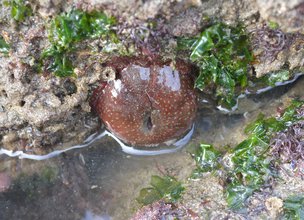A unique beach of rocky nature, with an ecosystem rich in biodiversity.
Praia Norte is located between the Union of the parishes of Viana do Castelo (Santa Maria Maior and Monserrate) and Meadela and the parish of Areosa. It consists of an urban beach, with a rocky nature. It presents a typical pattern of a beach sheltered with brown algae (Fucus spp., Pelvetia canaliculata and Ascophyllum nodosum). .
This beach has a very interesting biotope of high ecological richness. As a rocky beach, it is an ecosystem of high biodiversity, compared to sandy beaches. It is the habitat of countless marine species that, being subject to hostile abiotic factors, have developed adaptations to survive and successfully colonize the area.
Here, there are tide pools, typical of rocky beaches, functioning as a refuge for fauna and flora of lower levels of the beach, since the space of the puddle is not exposed to the air during low tide.
Due to its location in an urban area and proximity to intallations such as schools and the business district, demographic pressure on this beach is high, the trampling that rocks are subject to poses a serious threat to biodiversity, as well as the proliferation of some exotic and invasive species. However, the level of conservation and, consequently, the interest and ecological importance of this beach have been maintained.
In this place, inserted in the Special Conservation Zone of the North Coast, there is the habitat contained in the Habitats Directive:
- 1170 - Reefs
Praia Norte is located between the Union of the parishes of Viana do Castelo (Santa Maria Maior and Monserrate) and Meadela and the parish of Areosa. It consists of an urban beach, with a rocky nature. It presents a typical pattern of a beach sheltered with brown algae (Fucus spp., Pelvetia canaliculata and Ascophyllum nodosum). .
This beach has a very interesting biotope of high ecological richness. As a rocky beach, it is an ecosystem of high biodiversity, compared to sandy beaches. It is the habitat of countless marine species that, being subject to hostile abiotic factors, have developed adaptations to survive and successfully colonize the area.
Here, there are tide pools, typical of rocky beaches, functioning as a refuge for fauna and flora of lower levels of the beach, since the space of the puddle is not exposed to the air during low tide.
Due to its location in an urban area and proximity to intallations such as schools and the business district, demographic pressure on this beach is high, the trampling that rocks are subject to poses a serious threat to biodiversity, as well as the proliferation of some exotic and invasive species. However, the level of conservation and, consequently, the interest and ecological importance of this beach have been maintained.
In this place, inserted in the Special Conservation Zone of the North Coast, there is the habitat contained in the Habitats Directive:
- 1170 - Reefs
Location
Praia Norte is located between the parishes of Monserrate and Areosa, very close to the center of Viana do Castelo.
Coordinates
Lat: 41.694083
Long: -8.851417
Hello little one!
I'm Piquinhos and I can help you learn more about the Geopark!
Biodiversity
Biodiversity
Rocky beaches are typically highly biodiverse ecosystems. However, surviving on a rocky beach presupposes successfully overcoming several challenges related to the adverse conditions observed in these ecosystems. For this, fauna and flora have adaptations that allow them to colonize and live in the intertidal zone. Some survival challenges are:
- Rising and falling tide;
- Undulation;
- Variations in temperature;
- Variations in salinity;
- Variations in dissolved oxygen and pH;
- Type of substrate.
The low depth associated with the solid substrate and the high nutritional content of coastal waters promotes the growth of macroalgae. In the supralittoral zone of Praia Norte, fucoid algae, such as Fucus vesiculosus, occur, while in the infralittoral, true laminar forests (Laminariales Order) occur up to depths of 20-25 meters, depending on the clarity of the water. The seaweed Laminaria hyperborea occurs in more sheltered places, with less movement of sediments and stones, while the species Saccorhiza polyschides colonizes places more exposed to the action of waves and with greater movement of material. Other species of algae that can be found in the intertidal zone are Ulva spp., Codium tomentosum, Bifurcaria bifurcata, Lithophyllum spp., Corallina officinalis, Gelidium spp., among others. Some invasive exotic species occur on this beach, threatening the local indigenous biodiversity, as is the case of the Japanese sargasso (Sargassum muticum).
With the increase in depth and decrease in available light, the algae are being replaced by other living beings, namely benthic filter-feeders and suspension feeders.
Despite the harsh conditions of this ecosystem, associated with the rocks of Praia Norte there is a great diversity of fauna, such as limpets (Patella spp.), barnacles (Chthamalus spp.), mussels (Mytilus galloprovincialis), hermit crabs (Anapagurus laevis), spiny starfish (Marthasterias glacialis), octopus (Octopus vulgaris), anemones (Anemonia sulcata), sea urchins (Paracentrotus lividus), shrimp (Crangon crangon), montagu's blenny (Coryphoblennius galerita), among many other species.
Some birds can also be observed, such as the ruddy turnstone (Arenaria interpres), several species of gulls (Larus spp.), The gull-billed tern (Gelochelidon nilotica), the little egret (Egretta garzetta), the common greenshank (Tringa nebularia), among others.
Discover some of the species that can be found in this location, under the "Multimedia" tab.
Child Mode
Discover the geopark in a simpler format, aimed at the little ones.
Clique ENTER para pesquisar ou ESC para sair
